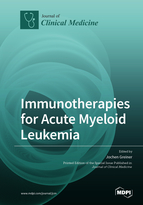Immunotherapies for Acute Myeloid Leukemia
A special issue of Journal of Clinical Medicine (ISSN 2077-0383). This special issue belongs to the section "Hematology".
Deadline for manuscript submissions: closed (20 December 2018) | Viewed by 48153
Special Issue Editor
2. Department of Internal Medicine III, University of Ulm, 89081 Ulm, Germany
Interests: immunology of malignant hematological diseases and various solid tumors; tumor mmunotherapy; stem cell transplantation and donor lymphocyte infusion; clinical hematology
Special Issue Information
Dear Colleagues,
The efficacy of immunotherapeutic approaches in the treatment of different cancer types becomes more and more obvious and immunotherapies in cancer treatment have experienced a significant breakthrough in the last few years. Immunotherapy encompasses several diverse treatment approaches, each of which has a distinct mechanism of action, and all of which are designed to boost or restore immune function in some manner. Consequently, T cell activating immunotherapeutic approaches like immune checkpoint inhibition, chimeric antigen receptor T cells (CARs) or bi-specific T cell activating antibodies are becoming increasingly important treatment strategies in different solid tumor types but also haematological malignancies. T cell responses against malignant cells play a major role in maintaining remission and prolonging overall survival in patients after allogeneic stem cell transplantation and donor lymphocyte infusions (DLI) due to graft-versus-leukemia effect. In acute myeloid leukemia (AML) after intensive chemotherapy most patients achieve a completeremission however; the overall survival for all AML patients, especially in elderly patients is still relatively low. Immunotherapeutic approaches for AML patients might be options to reduce the relapse rate and therefore improve overall survival. This special issue will focus on immunotherapeutic approaches in AML to begin with on established therapies like the allogeneic stem cell transplantation including new concepts improving the graft versus leukemia effect, but also on new efforts to improve immune responses like adoptive T cell transfer, immune checkpoint inhibition and bi-specific antibodies and CAR-T-cell approaches.
Prof. Dr. Jochen GreinerGuest Editor
Manuscript Submission Information
Manuscripts should be submitted online at www.mdpi.com by registering and logging in to this website. Once you are registered, click here to go to the submission form. Manuscripts can be submitted until the deadline. All submissions that pass pre-check are peer-reviewed. Accepted papers will be published continuously in the journal (as soon as accepted) and will be listed together on the special issue website. Research articles, review articles as well as short communications are invited. For planned papers, a title and short abstract (about 100 words) can be sent to the Editorial Office for announcement on this website.
Submitted manuscripts should not have been published previously, nor be under consideration for publication elsewhere (except conference proceedings papers). All manuscripts are thoroughly refereed through a single-blind peer-review process. A guide for authors and other relevant information for submission of manuscripts is available on the Instructions for Authors page. Journal of Clinical Medicine is an international peer-reviewed open access semimonthly journal published by MDPI.
Please visit the Instructions for Authors page before submitting a manuscript. The Article Processing Charge (APC) for publication in this open access journal is 2600 CHF (Swiss Francs). Submitted papers should be well formatted and use good English. Authors may use MDPI's English editing service prior to publication or during author revisions.
Keywords
- Immunotherapies in cancer treatment
- Acute myeloid leukemia (AML)
- Allogeneic stem cell transplantation
- Donor lymphocyte infusion (DLI)
- T cell responses
- Bi-specific antibodies
- Immune checkpoint inhibition
- Chimeric antigen receptor T cells (CARs)







